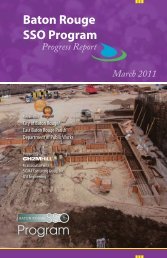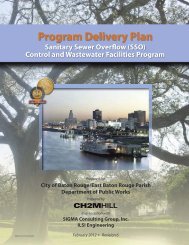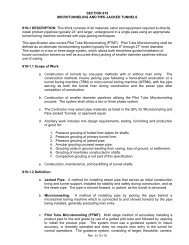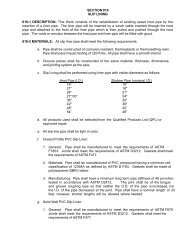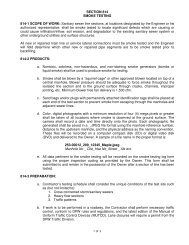Contents
Construction Management Plan - Baton Rouge Department of Public ...
Construction Management Plan - Baton Rouge Department of Public ...
- No tags were found...
You also want an ePaper? Increase the reach of your titles
YUMPU automatically turns print PDFs into web optimized ePapers that Google loves.
• Whenever possible observe the conditions from a flat surface and do not enter a steep ditch or<br />
side of a steep road bed.<br />
• If steep terrain must be negotiated, sturdy shoes or boots that provide ankle support should be<br />
used. The need for ladders or ropes to provide stability should be evaluated.<br />
2.2.28 Vehicular Traffic, Exposure to Public Vehicular Traffic<br />
Reference CH2M HILL SOP HSE&Q-216, Traffic Control)<br />
The following precautions must be taken when working around traffic, and in or near an area<br />
where traffic controls have been established by a contractor:<br />
• Exercise caution when exiting traveled way or parking along street – avoid sudden stops, use<br />
flashers, etc.;<br />
• Park in a manner that will allow for safe exit from vehicle, and where practicable, park vehicle<br />
so that it can serve as a barrier;<br />
• All staff working adjacent to traveled way or within work area must wear the appropriate<br />
ANSI/ISEA 107-1999 high-visibility safety vests;<br />
• Eye protection should be worn to protect from flying debris;<br />
• Remain aware of factors that influence traffic related hazards and required controls – sun glare,<br />
rain, wind, flash flooding, limited sight-distance, hills, curves, guardrails, width of shoulder<br />
(i.e., breakdown lane), etc.;<br />
• Always remain aware of an escape route -- behind an established barrier, parked vehicle,<br />
guardrail, etc.;<br />
• Always pay attention to moving traffic – never assume drivers are looking out for you;<br />
• Work as far from traveled way as possible to avoid creating confusion for drivers;<br />
• When workers must face away from traffic, a “buddy system” should be used, where one<br />
worker is looking towards traffic;<br />
• When working on highway projects, obtain a copy of the contractor’s traffic control plan;<br />
• Work area should be protected by a physical barrier – such as a K-rail or Jersey barrier;<br />
• Review traffic control devices to ensure that they are adequate to protect your work area; Traffic<br />
control devices should: 1) convey a clear meaning, 2) command respect of road users, and 3)<br />
give adequate time for proper traffic response. The adequacy of these devices are dependent on<br />
limited sight distance, proximity to ramps or intersections, restrictive width, duration of job,<br />
and traffic volume, speed, and proximity;<br />
• Either a barrier or shadow vehicle should be positioned a considerable distance ahead of the<br />
work area. The vehicle should be equipped with a flashing arrow sign and truck-mounted crash<br />
cushion (TMCC). All vehicles within 40 feet of traffic should have an orange flashing hazard<br />
light atop the vehicle;<br />
• Except on highways, flaggers should be used when 1) two-way traffic is reduced to using one<br />
common lane, 2) driver visibility is impaired or limited, 3) project vehicles enter or exit traffic in<br />
an unexpected manner, or 4) the use of a flagger enhances established traffic warning systems;<br />
• Lookouts should be used when physical barriers are not available or practical. The lookout<br />
continually watches approaching traffic for signs of erratic driver behavior and warns workers.<br />
Vehicles should be parked at least 40 feet away from the work zone and traffic. Minimize the<br />
amount of time that you will have your back to oncoming traffic.<br />
GNV310133632156.DOC/090840008 A-31



